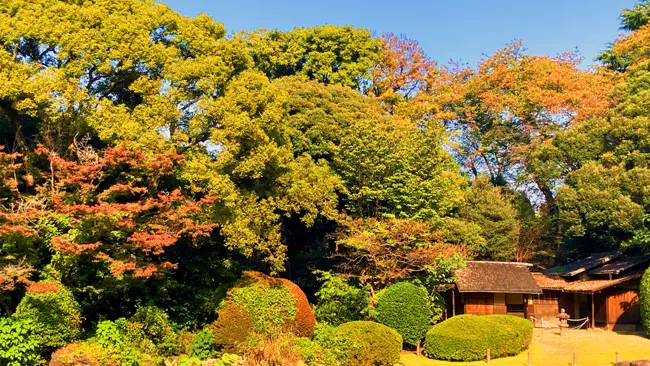The museum’s six exhibition galleries house a collection of approximately 120,000 artifacts, including 89 National Treasures and 648 Important Cultural Properties.

Tengoan today
The garden, which stretches across the north of the Tokyo National Museum’s Honkan (Japanese Gallery), has been planted with rare trees and wildflowers dating back to the museum’s founding.
At that time, it was home to the natural products department, a research division for plants and animals, offering visitors the opportunity to enjoy seasonal flowers and autumn foliage.
Five historical teahouses are interspersed around the central pond as well as a five-story pagoda and stone monuments presented to Horyuji (Horyu Temple) by the fifth shogun, Tsunayoshi Tokugawa.
One of the teahouses, “Tengoan,” was at one time owned by Matasaku Shiobara, founder of Sankyo Shoten, which later became Sankyo Co., Ltd. (Sankyo), one of the predecessors of Daiichi Sankyo.
Matasaku Shiobara, an enterprising businessperson and a man of culture
Matasaku Shiobara was a man of vision and determination. With two friends, he established Sankyo Shoten in 1898 in Yokohama and began importing and selling “Taka-Diastase,” a gastrointestinal medicine invented in the U.S. by scientific industrialist Dr. Jokichi Takamine.
Initially, Mr. Shiobara personally delivered the products to pharmacies in Tokyo; however, three years later, through his diligent efforts, the company grew to have licensed resellers in the Kanto and Kansai regions.
In 1902, Sankyo Shoten also pushed ahead with the import and sale of Dr. Takamine’s next invention, adrenaline, and when it was selected as the sole licensed reseller in Japan for Parke-Davis (now Pfizer), which sold adrenaline in the U.S., the number of drugs the company handled continued to steadily increase.
In the following years, on the recommendation of Dr. Jokichi Takamine, he accompanied Dr. Shibasaburo Kitasato and the renowned jurist Dr. Nobushige Hozumi to the U.S. to attend the St. Louis World’s Fair.
Sankyo Shoten expanded its business by developing new drugs, such as the nutritional supplement “Glyconal” and the lactobacillus preparation “Lactostase,” and became Sankyo Co., Ltd. in 1913 (for the story of the birth and development of Sankyo Shoten, click here).
Mr. Shiobara also had a cultural aspect, with a penchant for the Japanese art of tea ceremony and collecting antiques. He was chairperson of the “Saikokai,” a ceramics study group and owned several masterpieces that were considered National Treasures. He also had profound knowledge of architecture.
His ownership of the Tengoan teahouse was a testament to his deep interest in and knowledge of the Japanese culture.
Tengoan, a long-standing tradition where tea ceremonies are held to this day

Tengoan in the Autumn
Tengoan is a one-story wooden teahouse with a mountain-shaped gable roof, a four-and-a-half mat Japanese room, a preparation room, and other traditional features. It was originally erected in Rokujizo, Fushimi, Kyoto by Kobori Enshu, a feudal lord tea master of the early Edo period who inherited the tea ceremony school from Sen no Rikyu, among others, to display the “chaire” (tea caddy) called “Odaimyo” that he had been gifted from the imperial family.
In 1878, Kiyoshi Watanabe, who served as the Governor of Fukuoka Prefecture and Governor of Fukushima Prefecture, inherited the structure and moved it to Kasumi-cho, Azabu-ku (current Azabu, Minato-ku), Tokyo. It was then passed on to Shigeyoshi Mihara, an employee of the NYK shipping company, who also acquired the Odaimyo tea caddy, followed by Mr. Shiobara, who was well versed in tea ceremonies and ceramics.
Matasaku Shiobara passed away in 1955, and in 1963, his wife Chiyo donated both Tengoan and Odaimyo to the Tokyo National Museum.
Today, Tengoan is still open to the public for tea ceremonies, haiku readings, concerts, and other events, as well as regular “garden teahouse tours,” which offer an up-close look of the teahouses.